End of August i did a trip (as part of a wedding invitation) across Greece.
I started my journey in the second largest city of the country, Thessaloniki. Here i stayed a view days. Then I travelled south to Katerini for the wedding. After that I took the train to Athens.
Travelling by train in Greece
You can buy your tickets at the train stations or use the Hellenic Train App for your mobile device. I did both. Mostly you have to buy a seat reservation too. The trains itself are very comfortable.
But traveling by train was not as easy as in other countries. The reason was often lack of information about which platform the train leaves from. So you have to be prepared to ask someone or the staff at the information desk.
https://www.hellenictrain.gr/en
You can see my travelling route in the following map:
Athina, Attica, Greece
Korinos, Central Macedonia, Greece
Paralia, Central Macedonia, Greece
Petroto, Thessaly, Greece
Katerini, Central Macedonia, Greece
Thessaloniki, Central Macedonia, Greece
Thessaloniki
Thessaloniki, often referred to as Greece’s “co-capital” due to its historical significance and vibrant cultural scene, is a captivating city nestled along the azure shores of the Thermaic Gulf in the northern part of Greece. As the second-largest city in the country, Thessaloniki stands as a testament to the rich tapestry of Greek history, with roots dating back over two millennia.
Αψίδα Γαλερίου – Καμάρα (Arch of Galerius – Kamara), Εγνατία Οδός, Thessaloniki, Central Macedonia 546 35, Greece
Γερανός Λιμένα Θεσσαλονίκης (Thessaloniki Port, Thessaloniki Port Crane Monument)
Πλατεία Αριστοτέλους (Aristotelous Square), Πλατεία Αριστοτέλους, Thessaloniki, Central Macedonia 546 23, Greece
Λευκός Πύργος, Πλατεία Λευκού Πύργου, Thessaloniki, Central Macedonia 546 21, Greece
Άγαλμα Μεγάλου Αλεξάνδρου, Λεωφ. Βασιλέως Γεωργίου, Thessaloniki, Central Macedonia 546 21, Greece
Ομπρέλες, Λεωφ. Μεγάλου Αλεξάνδρου, Thessaloniki, Central Macedonia 546 40, Greece
Because of the hot weather conditions I did less sightseeing than normal. Most of the time I was close to the Thessaloniki waterfront. Here you can discover some good sights.
But let’s start at the airport. From there I took the X1 bus to the city center. It was funny to see that all the tourists (including myself) had Google Maps open to see when they had to leave the bus – all not yet familiar with the Greek characters.
As I arrived in the city center I saw already the first sights:
Arch of Galerius (Αψίδα Γαλερίου – Καμάρα)
One of the city’s most striking and historically significant landmarks is the Arch of Galerius. Standing proudly in the heart of the metropolis, this architectural marvel serves as a tangible link to Thessaloniki’s Roman past.
The Arch of Galerius, also known as Kamara, is a triumphal arch erected in the early 4th century to commemorate the victories of the Roman Emperor Galerius over the Persians. As you approach this impressive monument, you’ll be captivated by its intricate carvings and towering presence. Beyond its aesthetic beauty, the arch bears witness to centuries of history, witnessing the evolution of Thessaloniki from a Roman provincial capital to the thriving city it is today.
But of course the highlights are at the waterfront, which I explored the next day (all in walking distance):
Thessaloniki Port, Crane Monument (Γερανός Λιμένα Θεσσαλονίκης)
The Thessaloniki Port Crane Monument, also known as “The Portara,” is a striking and historically significant sculpture that pays homage to the city’s maritime heritage. Situated near the entrance of the Thessaloniki Port, this monumental installation features a giant crane rising dramatically against the backdrop of the sea.
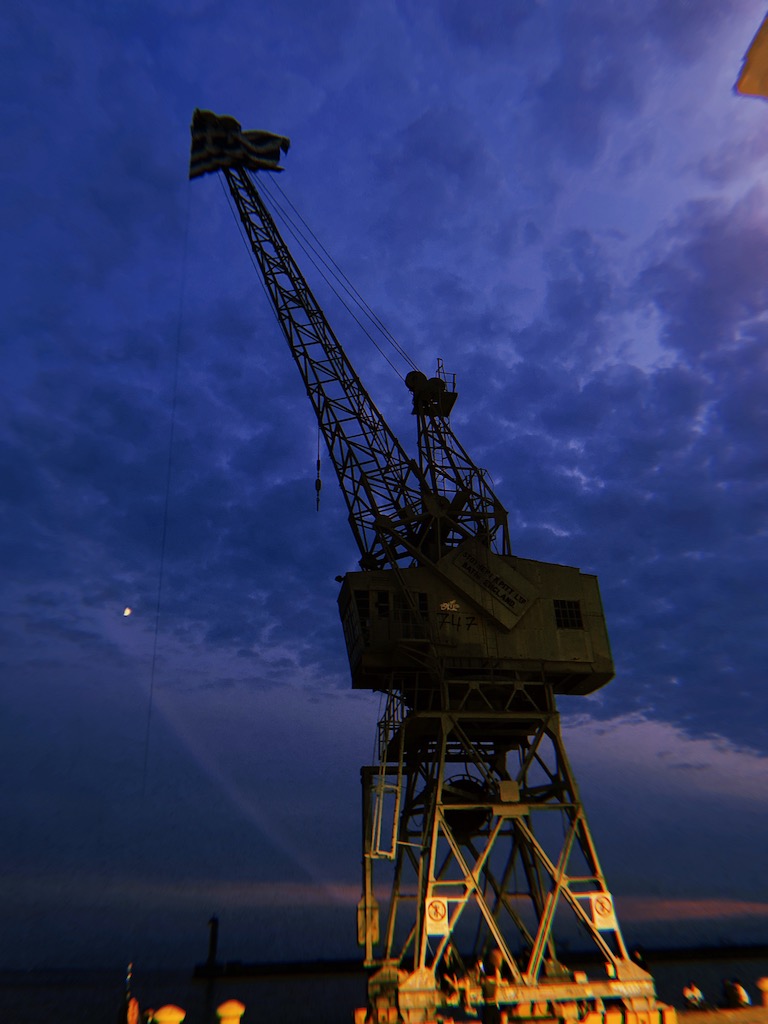
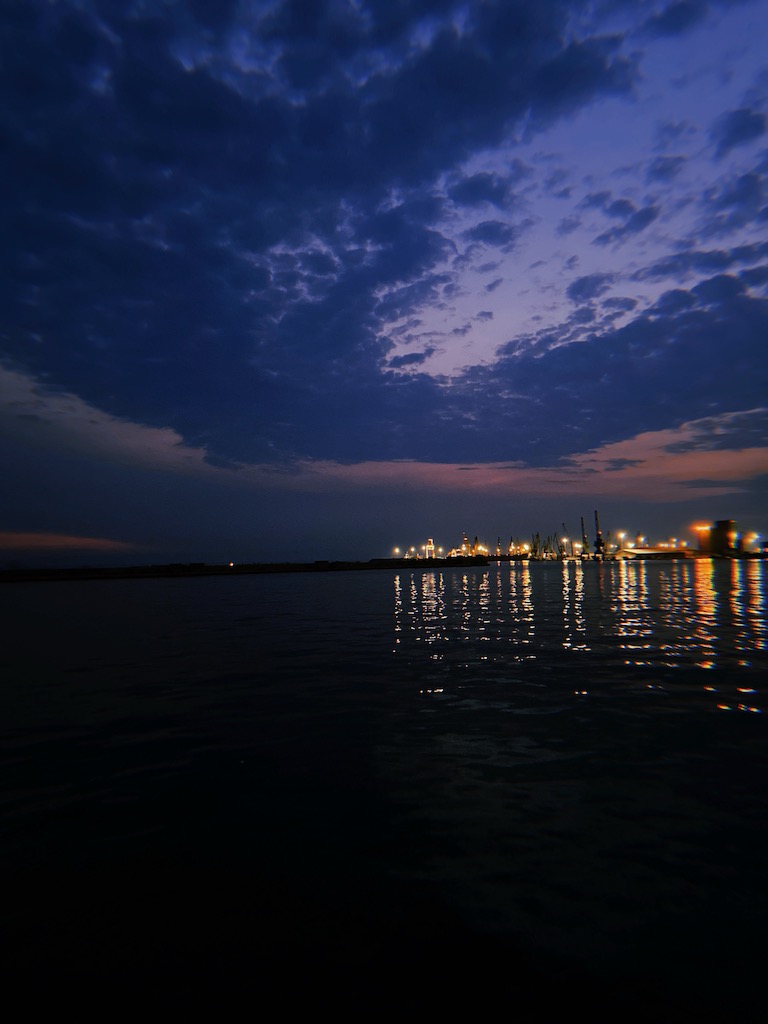
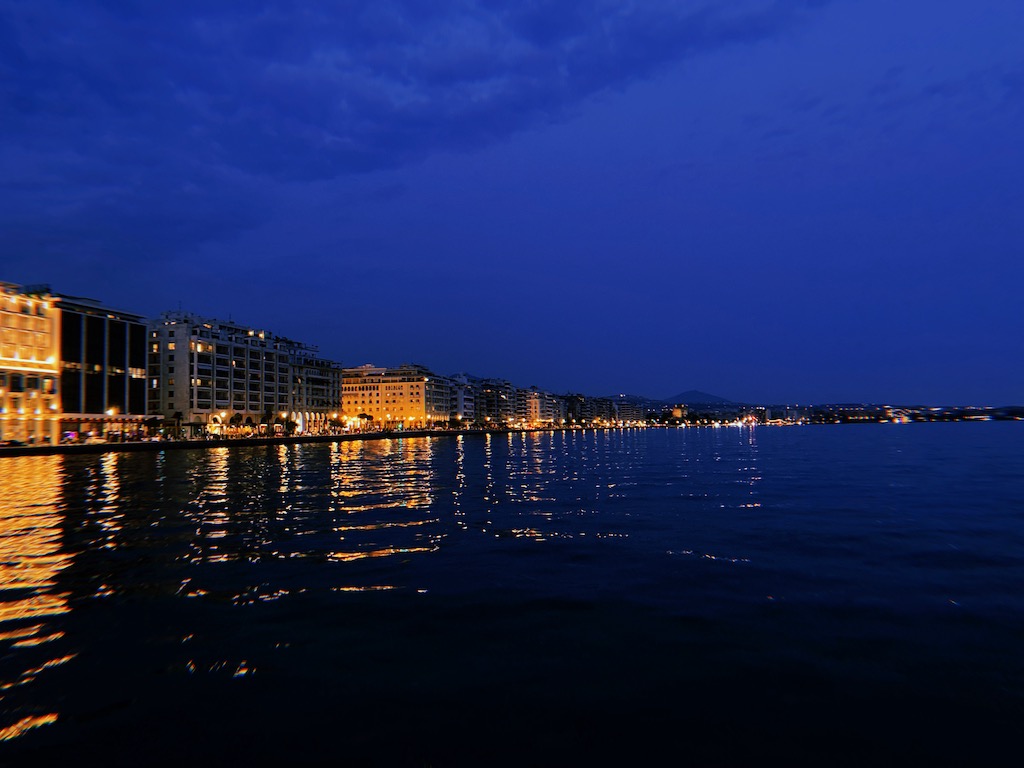
This sculpture serves as a poignant reminder of Thessaloniki’s role as a major port city for centuries, connecting Greece to the wider world. The crane symbolizes the city’s maritime commerce and trade, reflecting the importance of the port in shaping the region’s history and culture.
Aristotelous Square (Πλατεία Αριστοτέλους)
Aristotelous Square, located at the heart of Thessaloniki, is a bustling and elegant urban plaza that epitomizes the city’s vibrant spirit. Named after the famous ancient Greek philosopher Aristotle, the square offers a harmonious blend of neoclassical architecture, modernity, and Mediterranean charm.
Lined with cafes, shops, and restaurants, Aristotelous Square is a popular gathering place for both locals and tourists. It serves as a hub for cultural events, live performances, and a vibrant street life, making it an ideal spot to soak in the city’s atmosphere.
White tower of Thessaloniki (Λευκός Πύργος)
The White Tower of Thessaloniki stands as an iconic sentinel on the city’s waterfront, overlooking the azure waters of the Aegean Sea.
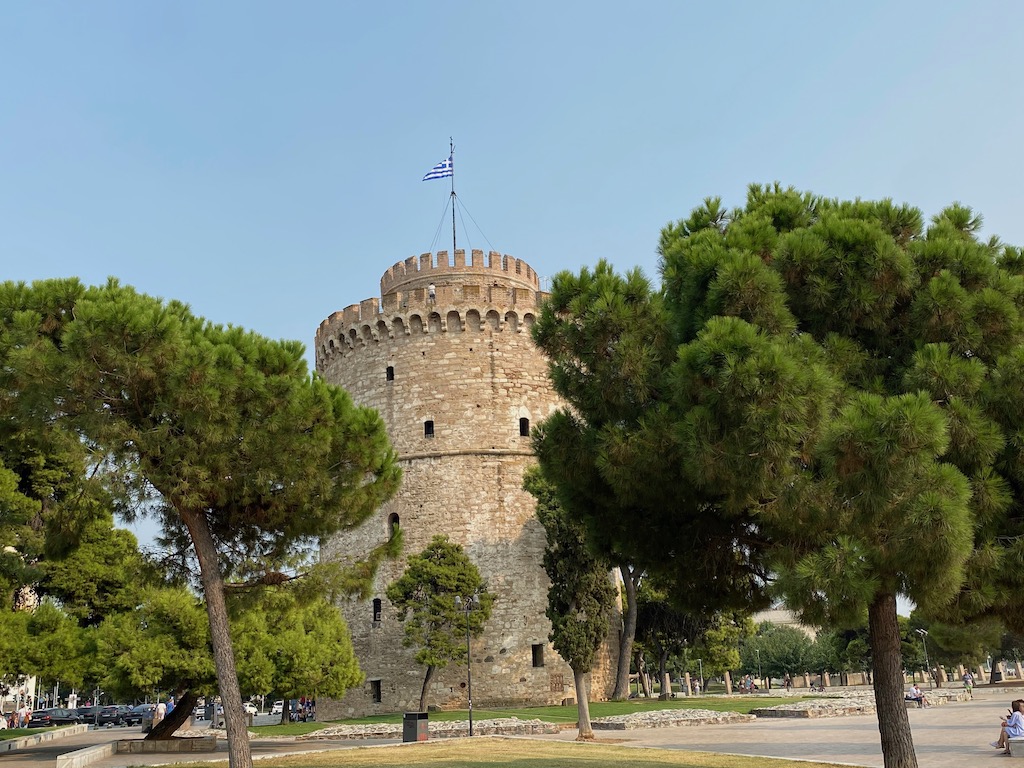
This elegant cylindrical tower, with its distinct white facade and conical roof, has become one of Thessaloniki’s most recognizable symbols. Originally built by the Ottomans in the 15th century, the tower has served various purposes over the centuries, from a fortress and prison to a symbol of the city’s rich history and maritime heritage.
Today, the White Tower houses a fascinating museum that chronicles the history of Thessaloniki and the broader region of Macedonia. Visitors can ascend its spiral staircase to take in panoramic views of the city and the sea, making it a must-visit attraction.
Statue of Alexander the Great (Άγαλμα Μεγάλου Αλεξάνδρου)
The Statue of Alexander the Great in Thessaloniki is a majestic tribute to one of history’s most renowned conquerors. Dominating the city’s central waterfront, this larger-than-life bronze statue captures the essence of Alexander, who hails from the ancient Macedonian region that includes Thessaloniki. Mounted on his famous horse, Bucephalus, Alexander is depicted in a triumphant pose, sword raised high.
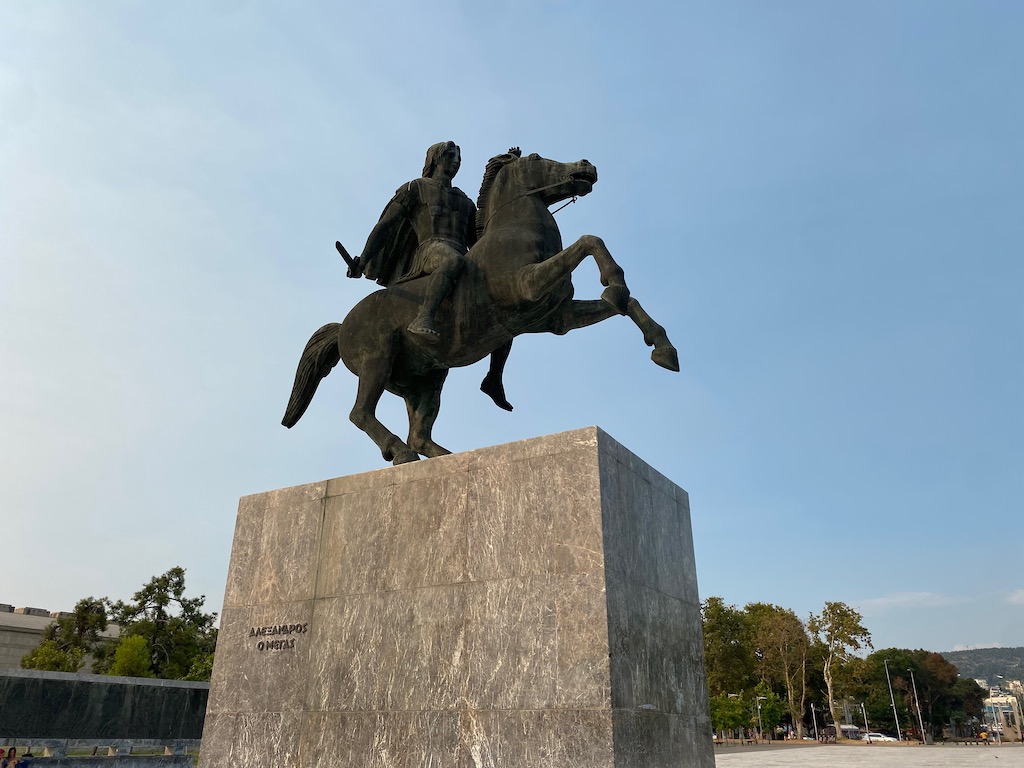
The statue serves as a powerful symbol of the city’s historical connection to Alexander and the enduring legacy of Macedonia. It is not only a remarkable work of art but also a reminder of the rich history and cultural heritage that have shaped Thessaloniki and the broader region. As visitors admire this imposing monument, they are transported back in time to an era when Alexander the Great’s ambition and conquests reshaped the world.
The Umbrellas by Zongolopoulos (Ομπρέλες)
“The Umbrellas” by George Zongolopoulos is an enchanting and thought-provoking art installation that graces the waterfront of Thessaloniki. Comprising a series of large, bronze umbrellas suspended in the air, this sculpture is a captivating display of modern art that has become an iconic symbol of the city.
By day, the umbrellas glisten in the sunlight, casting intricate shadows on the ground, while by night, they are beautifully illuminated, creating a mesmerizing visual spectacle. Zongolopoulos’ creation is more than just an aesthetic masterpiece; it serves as a conversation piece, prompting contemplation on the interplay of light, form, and function.
E-Bike tour from the Thessaloniki Port to the Thessaloniki Concert Hall
In the evening hours I did also a short bike tour to explore the nice waterfront area. Therefore I used one of the E-Bikes you can rent. I booked one on the Freenow App. There is a beautiful bike path between the port and the concert hall. It has a distance of 10km (both ways).
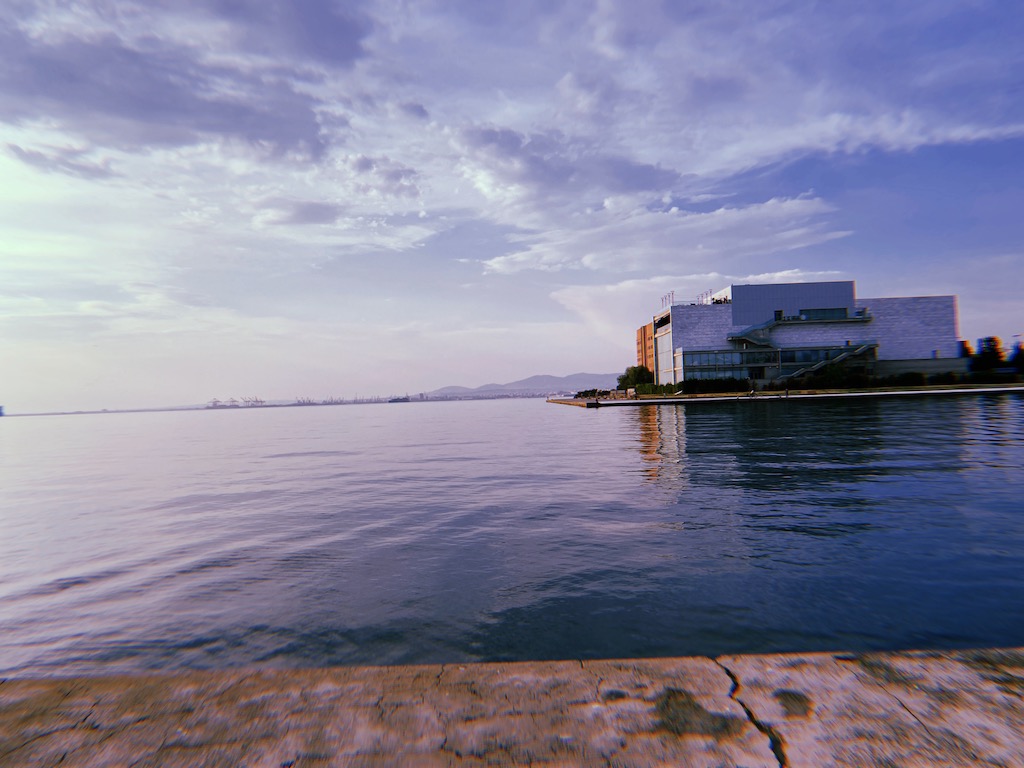
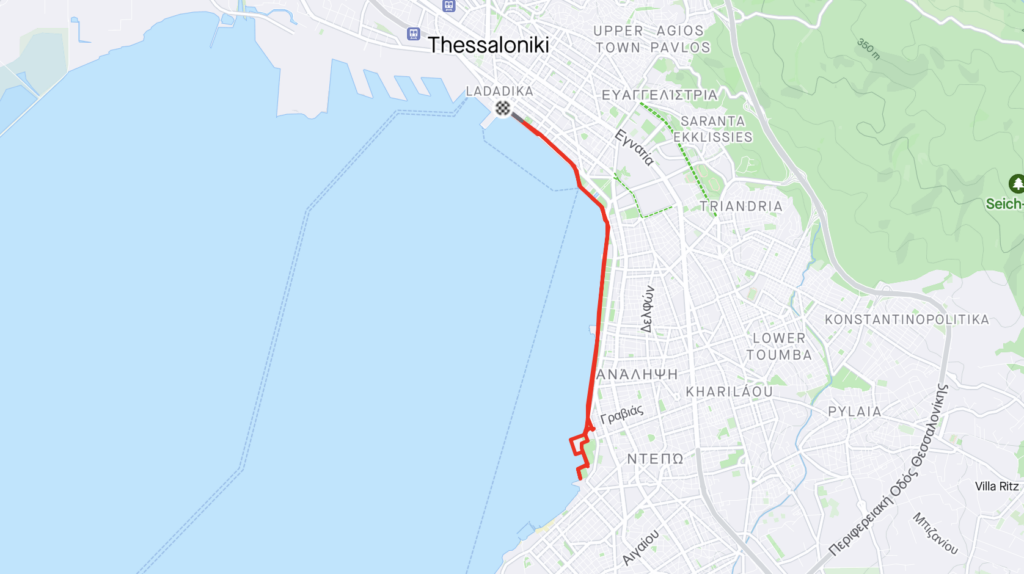
Katerini, Paralia, Petroto, Korinos – Wedding in paradise
From Thessaloniki I travelled by train to Katerini (around 1 hour). Now I was in the area where the wedding took place. But first I had to go to my hotel. It was in Paralia – a small town directly at the sea (Thermaic Gulf).
Paralia, meaning “beach” in Greek, is a term used to describe several coastal towns and resorts across Greece. One popular destination referred to as Paralia is Paralia Katerinis. It is a well-loved holiday spot for both locals and tourists, offering a blend of sun, sea, and vibrant entertainment.
Paralia Katerinis boasts a bustling promenade lined with shops, restaurants, and cafes, making it an ideal destination for those seeking a quintessential Greek beach experience.
In Greece, it is traditional to have a pre-wedding party in the groom’s town before the wedding. In our case the pre-wedding party was in Petroto. Petroto is a lovely small town in the middle of Greece.
The wedding ceremony itself took place in Korinos. Korinis is a small town close to Paralia. The wedding party was held again in Paralia. It all felt like in a movie. I can highly recommend the hotel/resort where the party took place. I added some impressions of the area, so you get a feeling of what I mean.
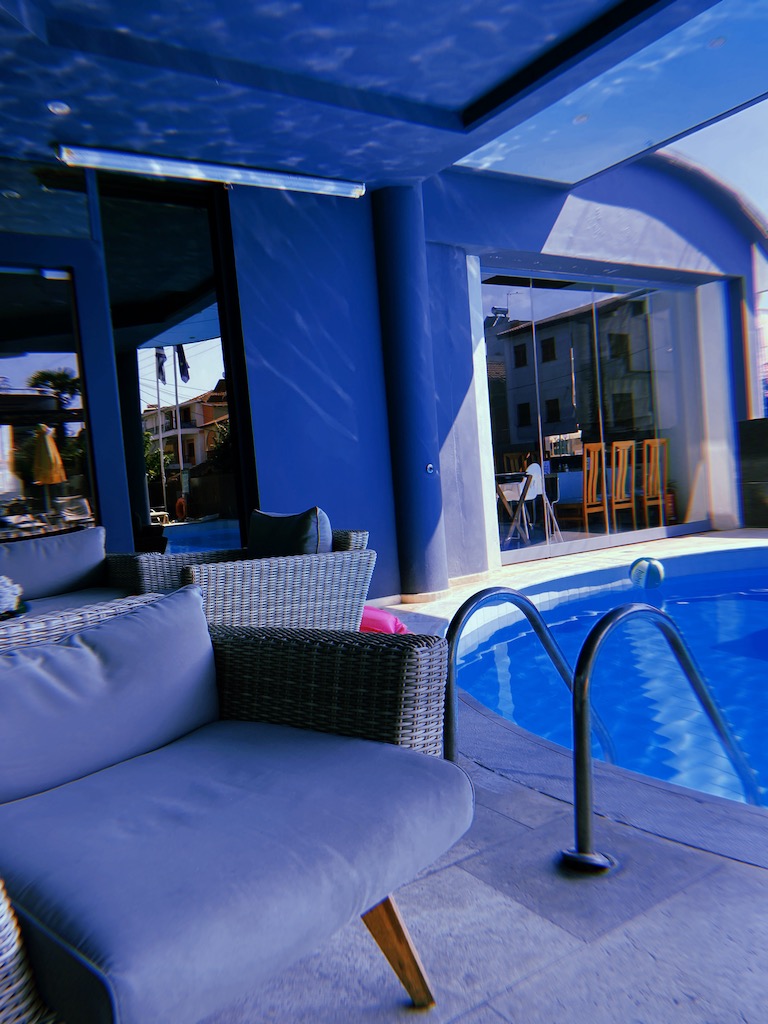
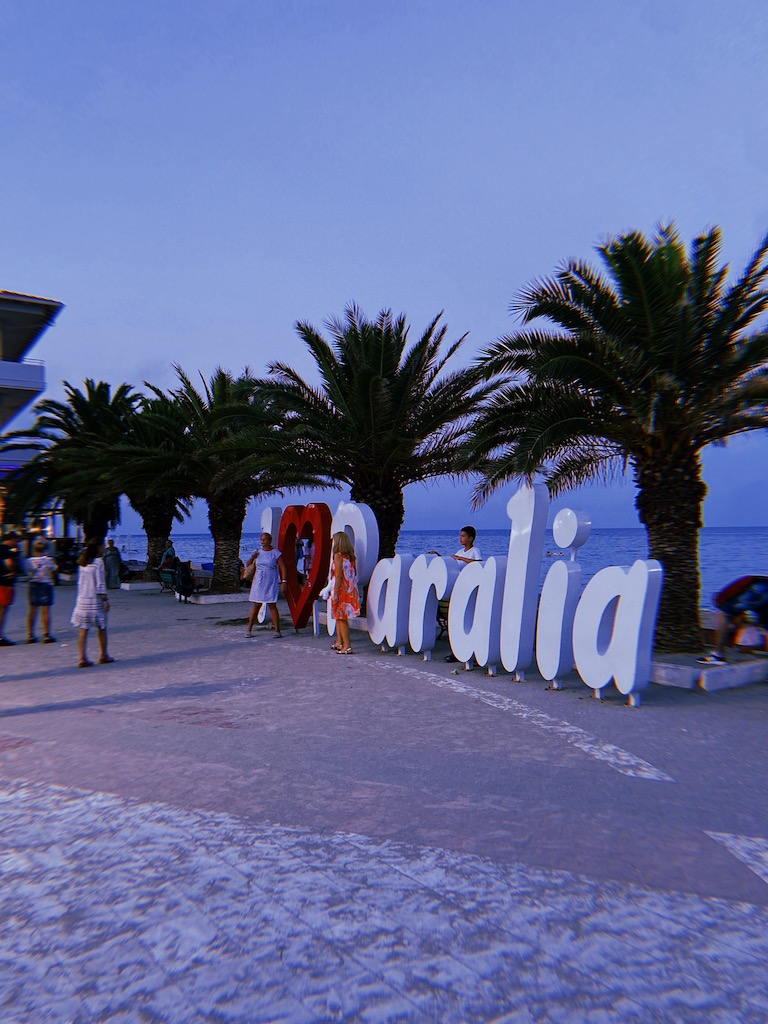
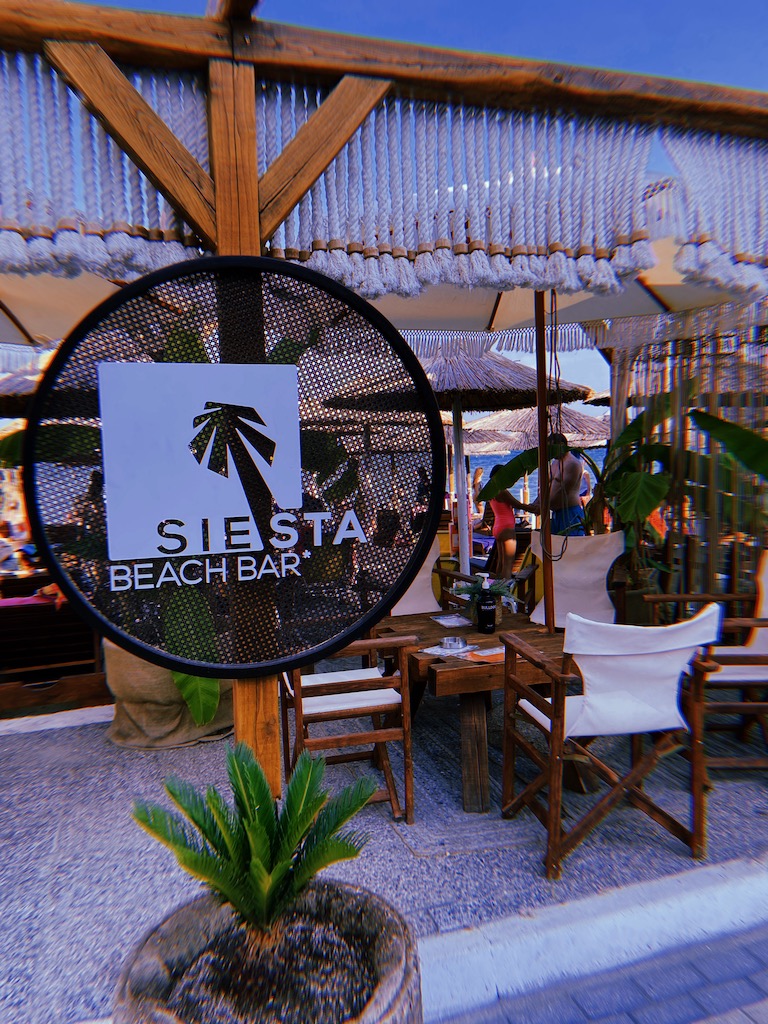
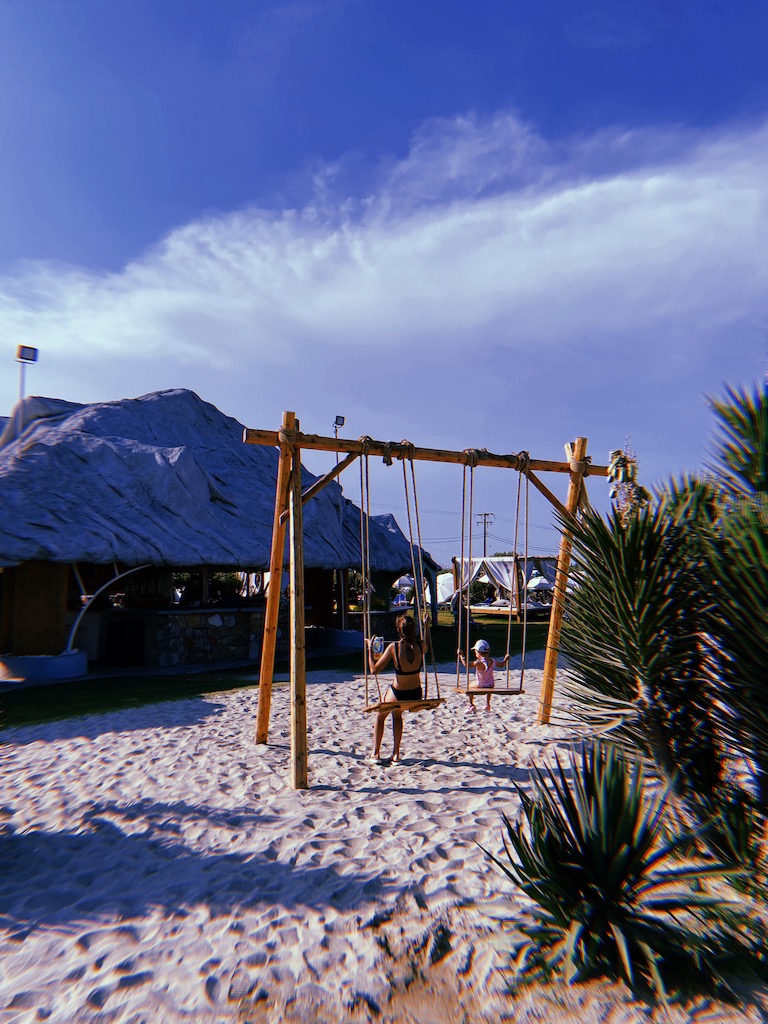
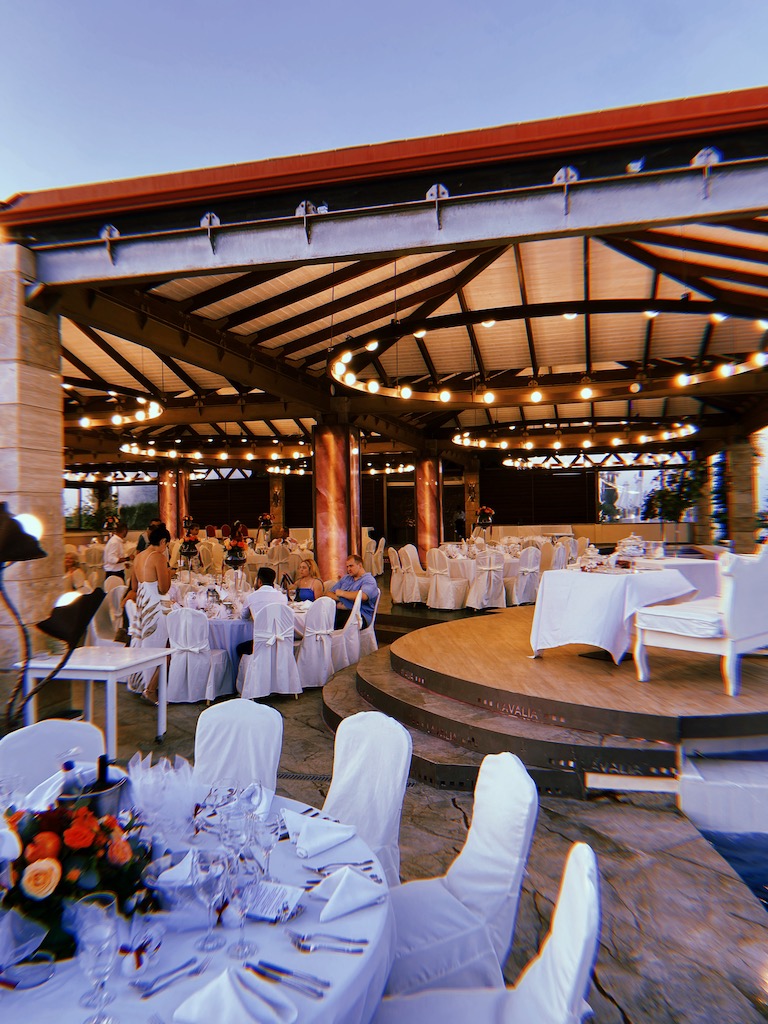
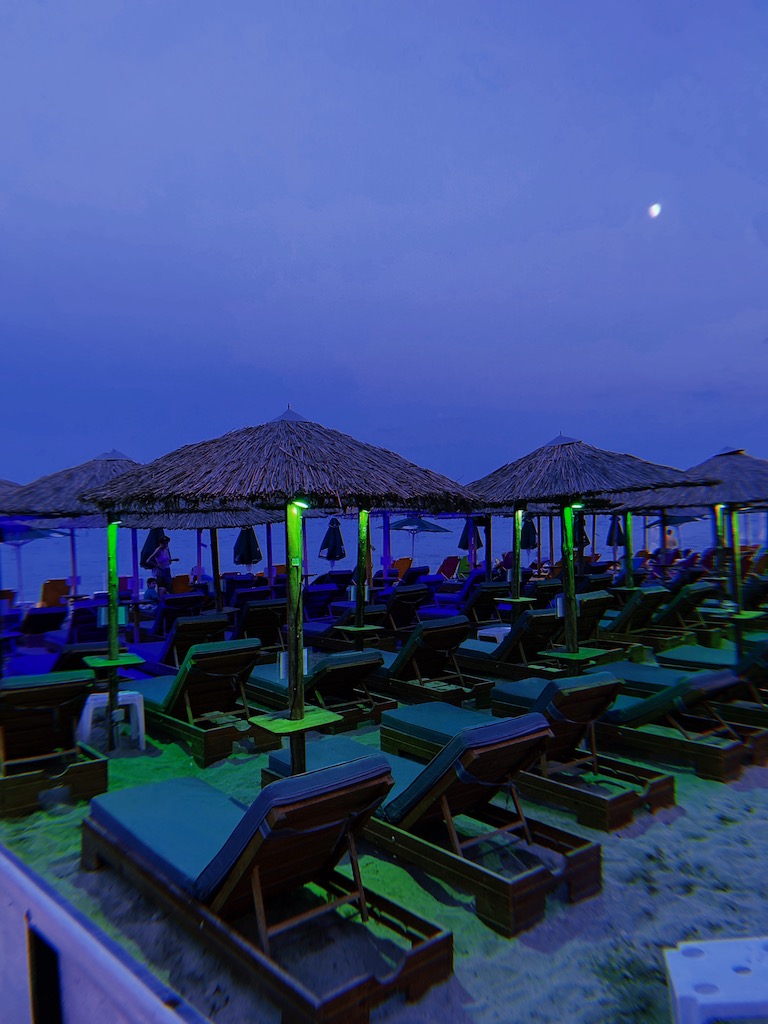
Athens
After this beautiful wedding I headed to Athens. This captivating city is a treasure trove of archaeological wonders and charming neighborhoods. With a history dating back over 3,400 years, Athens is often referred to as the cradle of Western civilization, and its rich heritage is palpable as you explore its iconic landmarks like the Acropolis.
But Athens isn’t just a city frozen in time; it’s a dynamic metropolis that embraces contemporary art, culture, and a lively nightlife scene. Join us as we embark on a journey through Athens, where the past meets the present in a tapestry of unforgettable experiences.
Ακρόπολη Αθηνών (Acropolis of Athens), Ακρόπολη Αθηνών, Athina, Attica 105 58, Greece
Mnisikleous, 105 56 Athina, Greece
Μουσείο Ακρόπολης (Acropolis Museum), Διονυσίου Αρεοπαγίτου 15, Athina, Attica 117 42, Greece
Ωδείο Ηρώδου Αττικού (Herod Atticus Odeon), Διονυσίου Αρεοπαγίτου, Athina, Attica 105 55, Greece
Ναός Ολυμπίου Διός (Temple Of Olympian Zeus), Λεωφ. Βασιλίσσης Ολγας, Athina, Attica 105 57, Greece
Παναθηναϊκό Στάδιο – Καλλιμάρμαρο (Panathenaic Stadium), Λεωφ. Βασιλέως Κωνσταντίνου, Athina, Attica 116 36, Greece
Ζάππειος Κήπος (Zappeion Gardens), Λεωφ. Βασιλίσσης Όλγας, Athina, Attica 105 57, Greece
Εθνικός Κήπος (National Garden), Λεωφ. Βασιλίσσης Αμαλίας 1, Athina, Attica 105 57, Greece
Syntagma Square, Athens Greece, Athina, Attica 105 63, Greece
Piraeus harbor, Pireas, Attica 185 38, Greece
Edem Beach, Λεωφ. Ποσειδώνος 72, Paleo Faliro, Attica 175 62, Greece
Akropolis (Ακρόπολη Αθηνών)
The Acropolis of Athens, an ancient citadel perched high above the bustling streets of modern Athens, is a beacon of Greece’s rich history and architectural prowess. This UNESCO World Heritage site is home to some of the most iconic and well-preserved ancient Greek structures, including the majestic Parthenon, the elegant Erechtheion, and the grand Temple of Hephaestus.
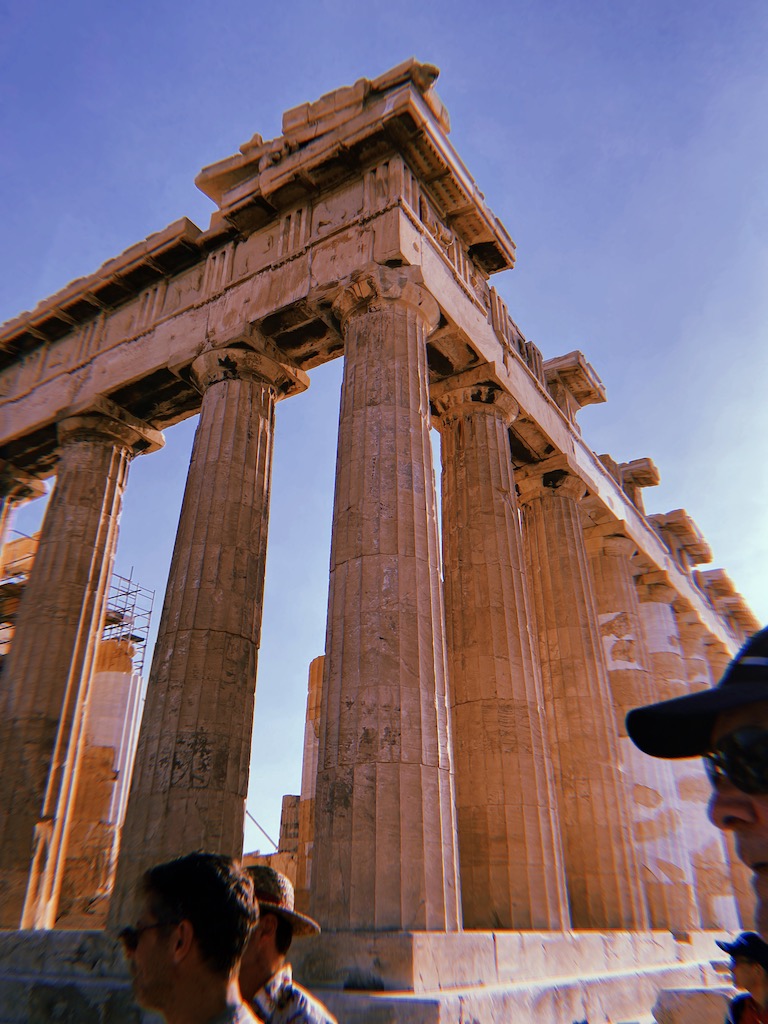
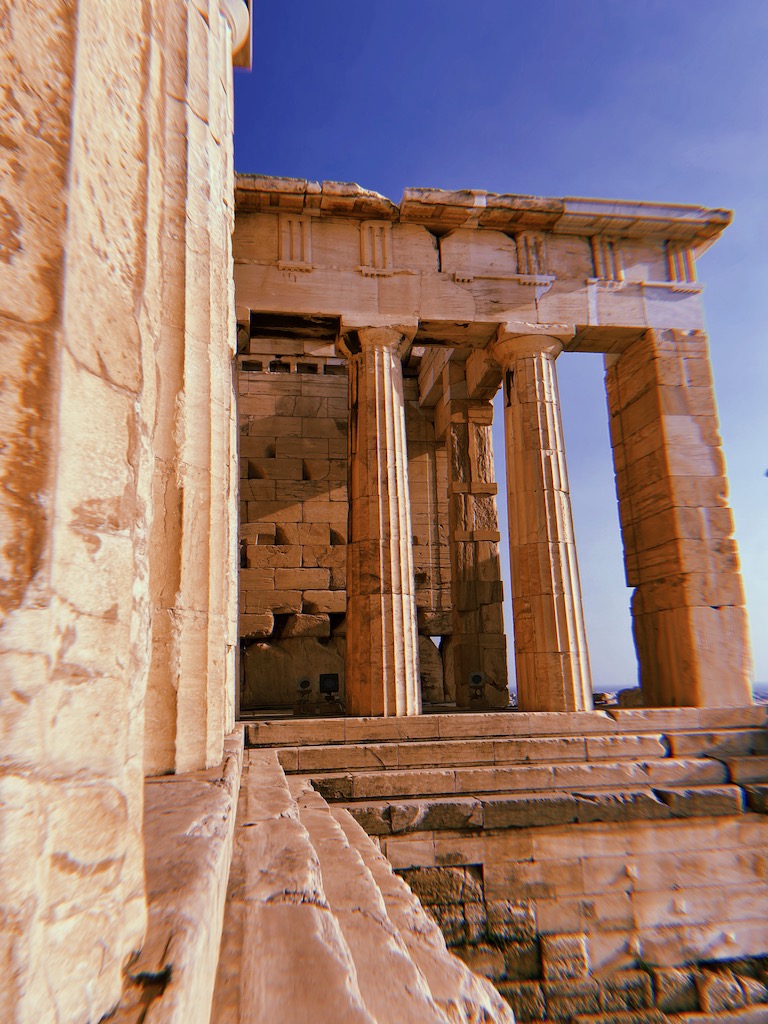
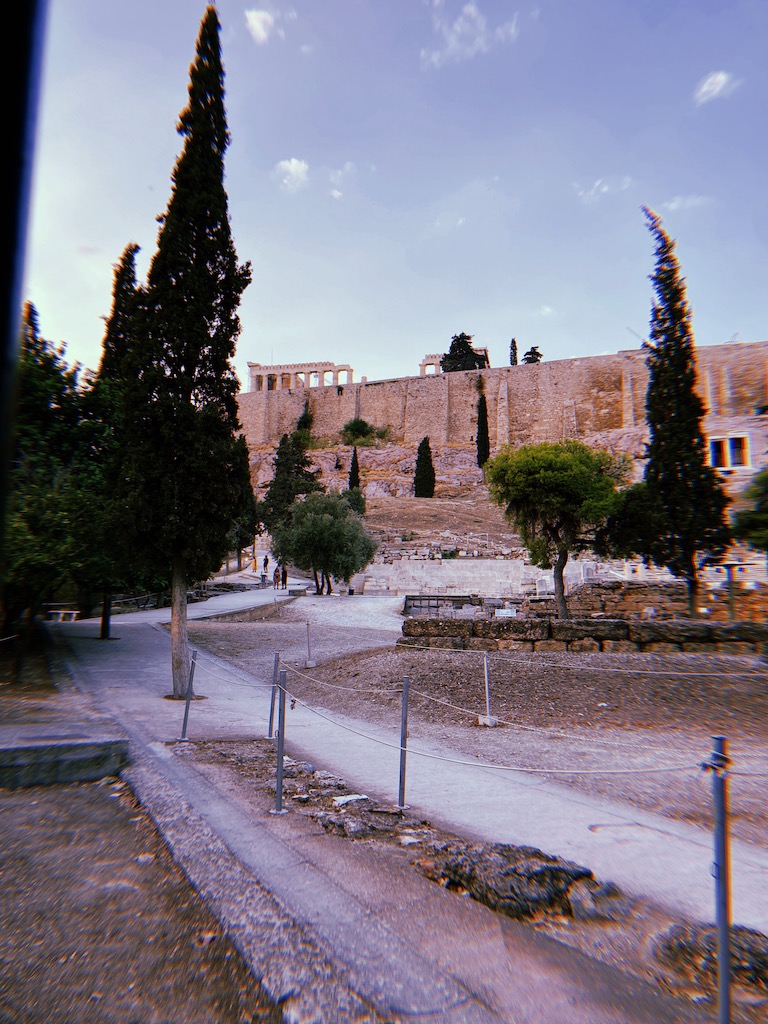
As you ascend the sacred rock and explore the marbled pathways of the Acropolis, you’ll be transported back in time to an era of gods, philosophers, and the birth of Western culture. The Acropolis is not just a historical site; it’s a symbol of human achievement and a testament to the enduring legacy of ancient Greece.
Furthermore the Akropoli metro station is not only a good stop to start your Acropolis experience it is also worth to visit the area of it with the little restaurants, cafes und parks.
Acropolis Museum (Μουσείο Ακρόπολης)
The Acropolis Museum, an architectural marvel nestled at the foothills of the majestic Acropolis in Athens. This modern museum stands as a beacon of ancient art and culture, showcasing a remarkable collection of artifacts and sculptures that tell the captivating story of the Acropolis and its significance in Greek history.
With its sleek design and expansive galleries, the Acropolis Museum offers visitors a unique opportunity to delve into the rich heritage of ancient Athens. From the intricately carved marble friezes of the Parthenon to the meticulously preserved artifacts from the surrounding archaeological sites, the museum provides an immersive journey through the Golden Age of Greece.
Tickets and more: https://www.theacropolismuseum.gr/en
Mnisikleous street in Plaka neighborhood
On the north-east side of the Acropolis hill (after leaving the exit) I found the area of Plaka known as the “Neighborhood of the Gods”. With its pretty little streets and famous staircases, the area is truly picturesque.
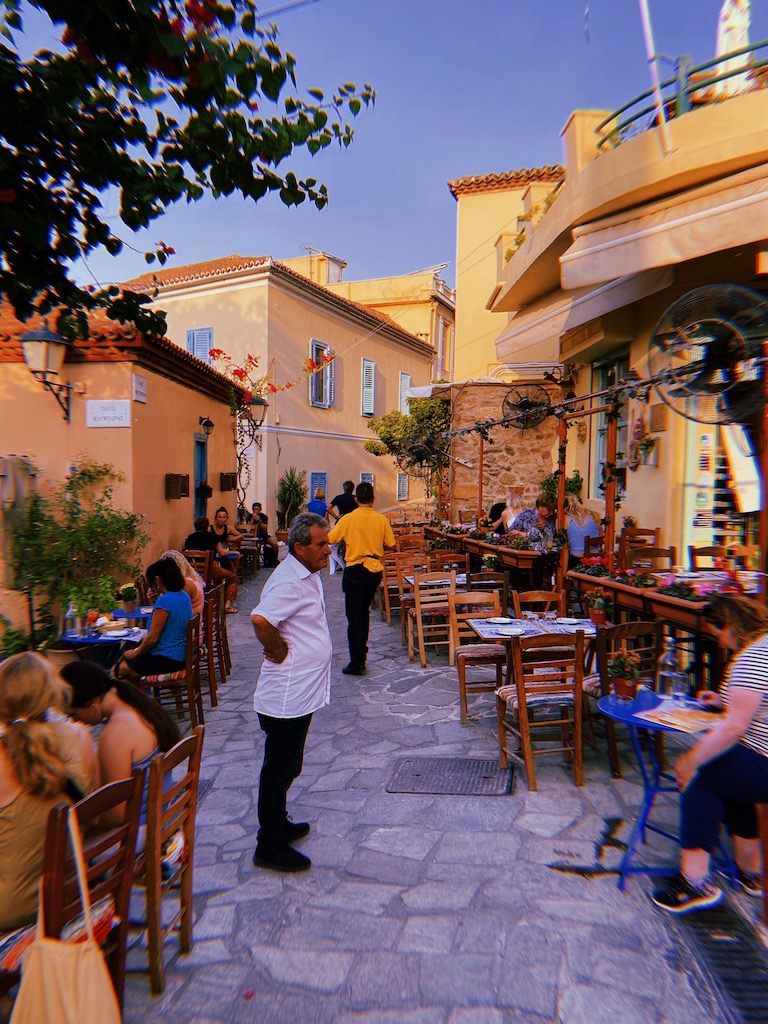
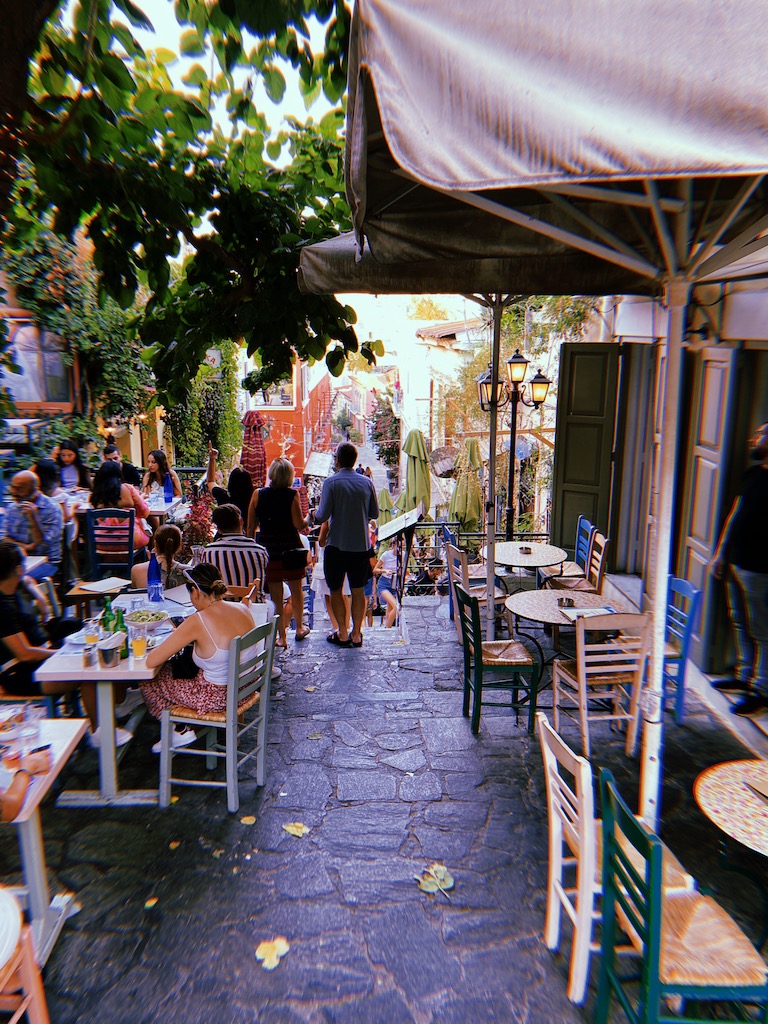
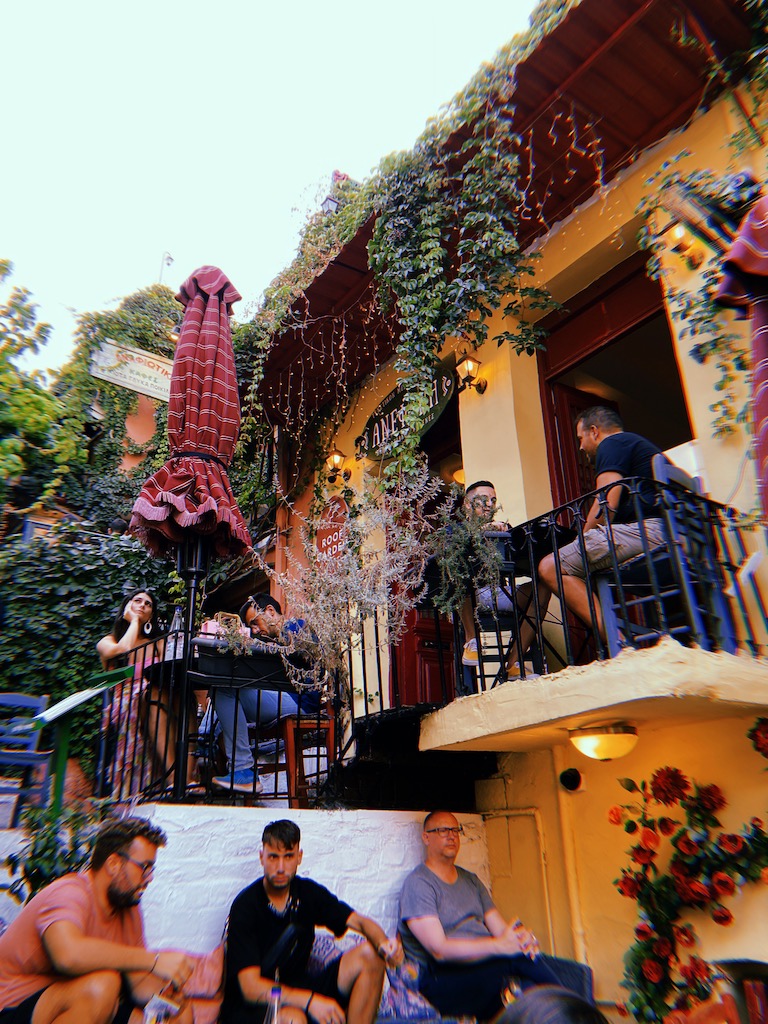
Odeon des Herodes Atticus (Ωδείο Ηρώδου του Αττικού)
The Odeon of Herodes Atticus, a marvel of ancient Greek architecture, is a timeless amphitheater nestled on the southern slopes of the Acropolis in Athens. Built in 161 AD by the wealthy Athenian Herodes Atticus in memory of his wife, the theater has been a stage for the performing arts for nearly two millennia.
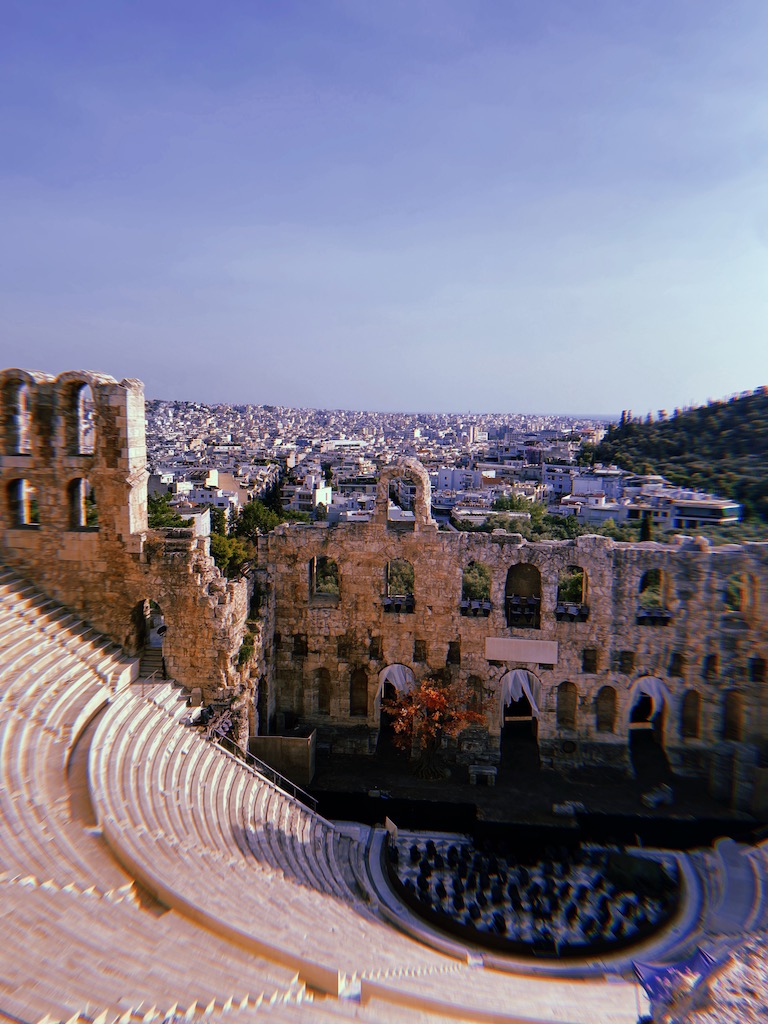
This well-preserved odeon, with its impressive stone arches and seating capacity of over 5,000, has hosted countless concerts, theatrical performances, and cultural events over the years. Today, it continues to be a celebrated venue for the Athens Festival, where visitors can immerse themselves in the beauty of the ancient world while enjoying world-class performances against the backdrop of the illuminated Acropolis.
Olympieion (Ναός του Ολυμπίου Διός)
The Olympieion, also known as the Temple of Olympian Zeus, is an awe-inspiring ancient temple complex located in Athens. This colossal monument, dedicated to the king of the Olympian gods, Zeus, is a testament to the grandeur and ambition of the ancient Greeks.
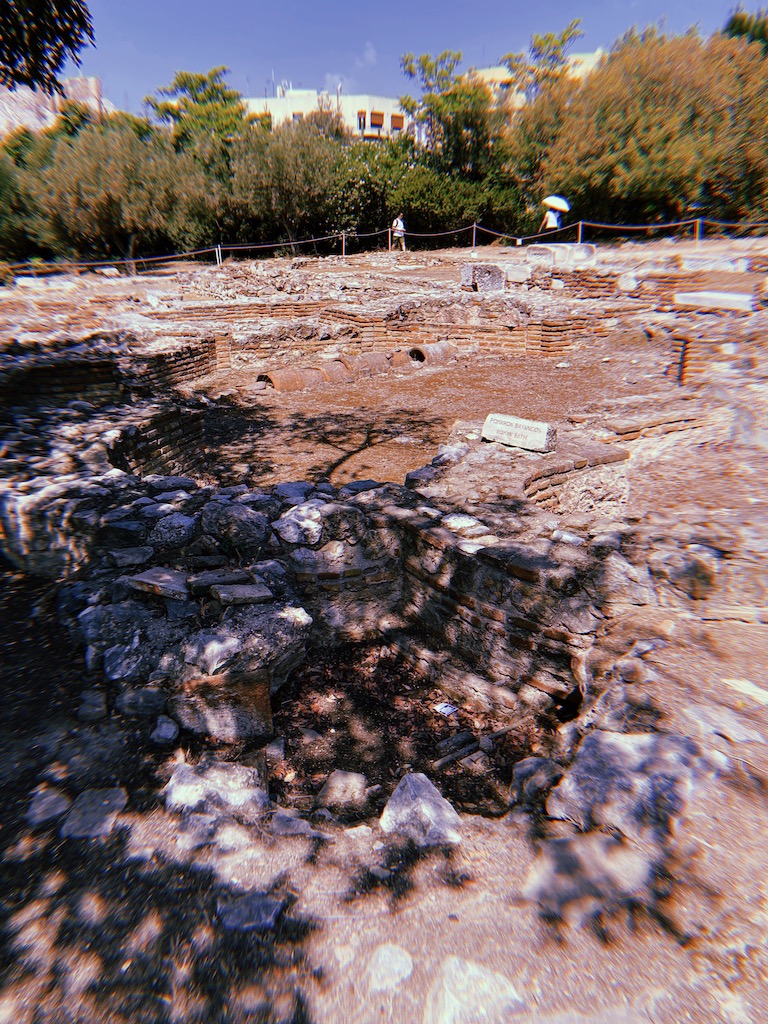
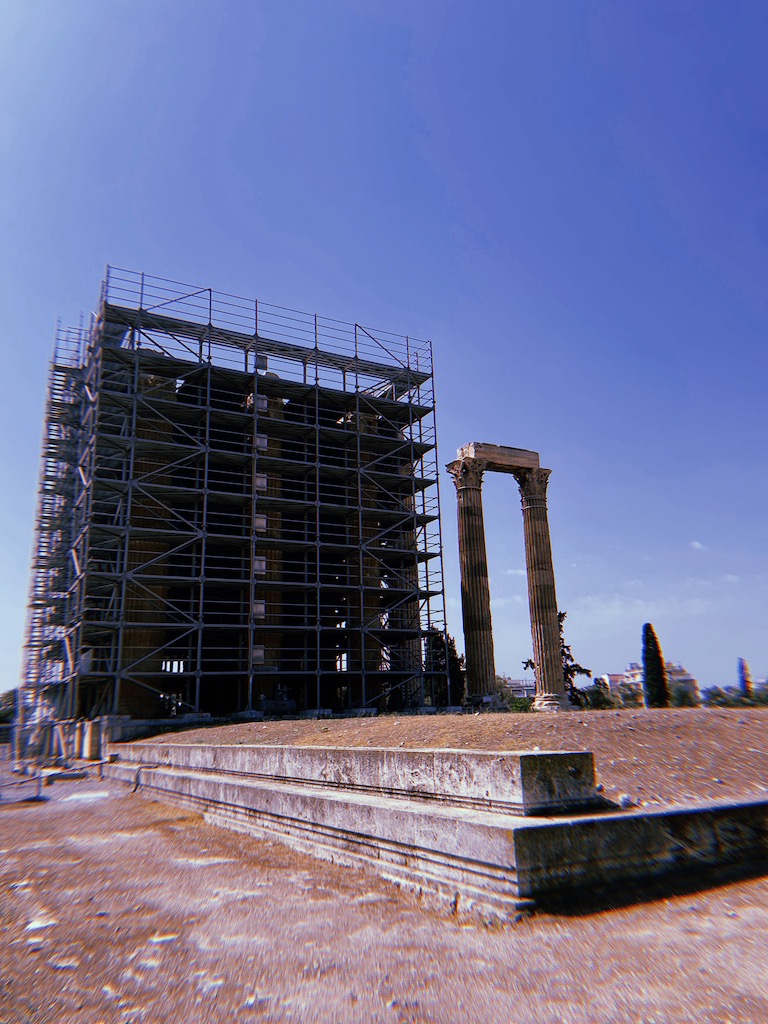
Construction of the temple began in the 6th century BC but was not completed until the reign of the Roman Emperor Hadrian in the 2nd century AD, making it one of the largest temples in the ancient world. Its sheer size, with towering columns reaching 17 meters in height, showcases the architectural prowess of its time.
Panathenaic Stadium (Παναθηναϊκό Στάδιο)
The Panathenaic Stadium, also known as Kallimarmaro, is a remarkable athletic arena nestled in the heart of Athens. What makes this stadium truly exceptional is that it’s the only stadium in the world built entirely of white marble, a nod to ancient Greek architectural elegance.
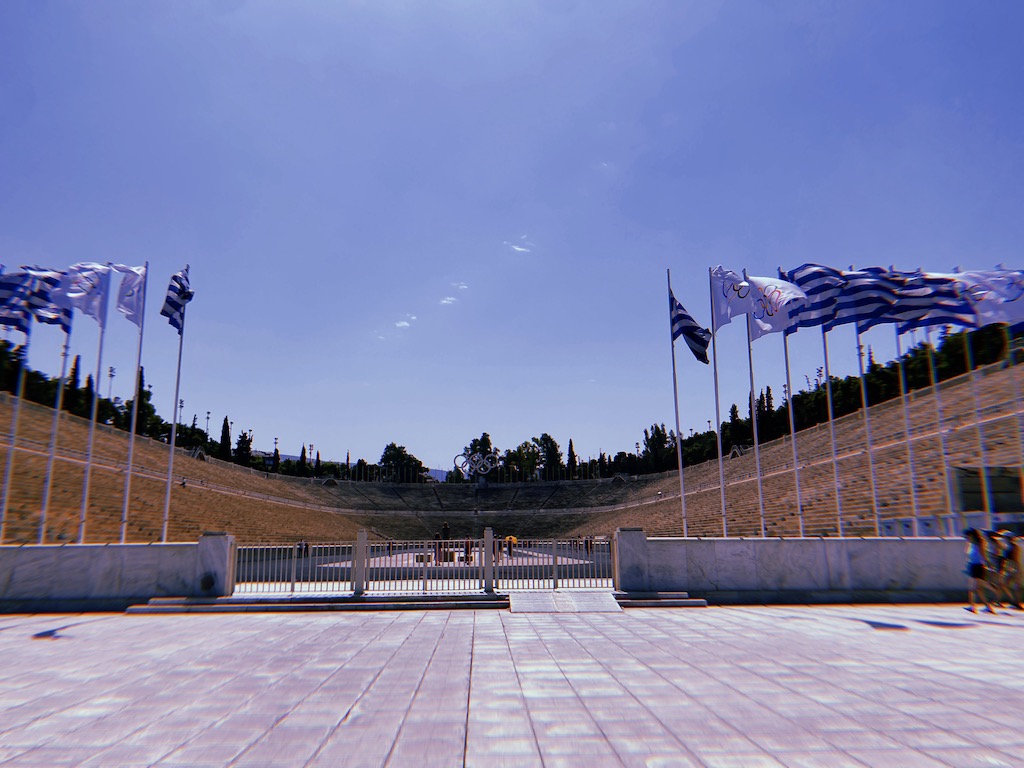
Originally constructed in the 4th century BC, the stadium was rebuilt in its current form by the Roman Emperor Herodes Atticus in 144 AD. It hosted the Panathenaic Games, a major sporting and cultural event of ancient Greece, and later became the site of the first modern Olympic Games in 1896.
Today, the Panathenaic Stadium serves as a symbol of the enduring Olympic spirit and a popular tourist attraction.
Zappeion Garden (Κήποι Ζαππείουx) and Zappeio Roman Baths (Ρωμαϊκά Λουτρά Ζαππείου)
The Zappeion, an architectural marvel situated in Athens, stands as a symbol of Greek history and culture. Built in the late 19th century, it was initially designed to house events related to the revival of the Olympic Games, and its neoclassical style is a testament to the grandeur of that era.
The Zappeion Garden, surrounding the Zappeion building, is a lush oasis in the heart of Athens. This well-maintained park offers a tranquil escape from the bustling city, with beautifully landscaped gardens, statues, and fountains that invite visitors to relax and enjoy nature’s beauty.
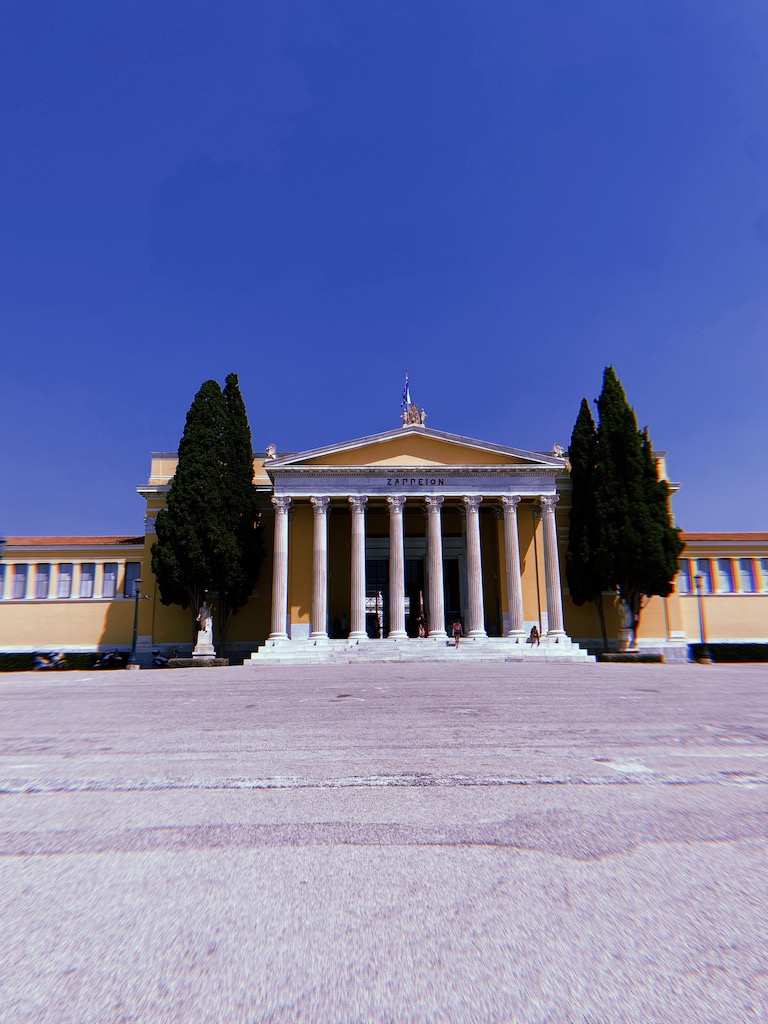
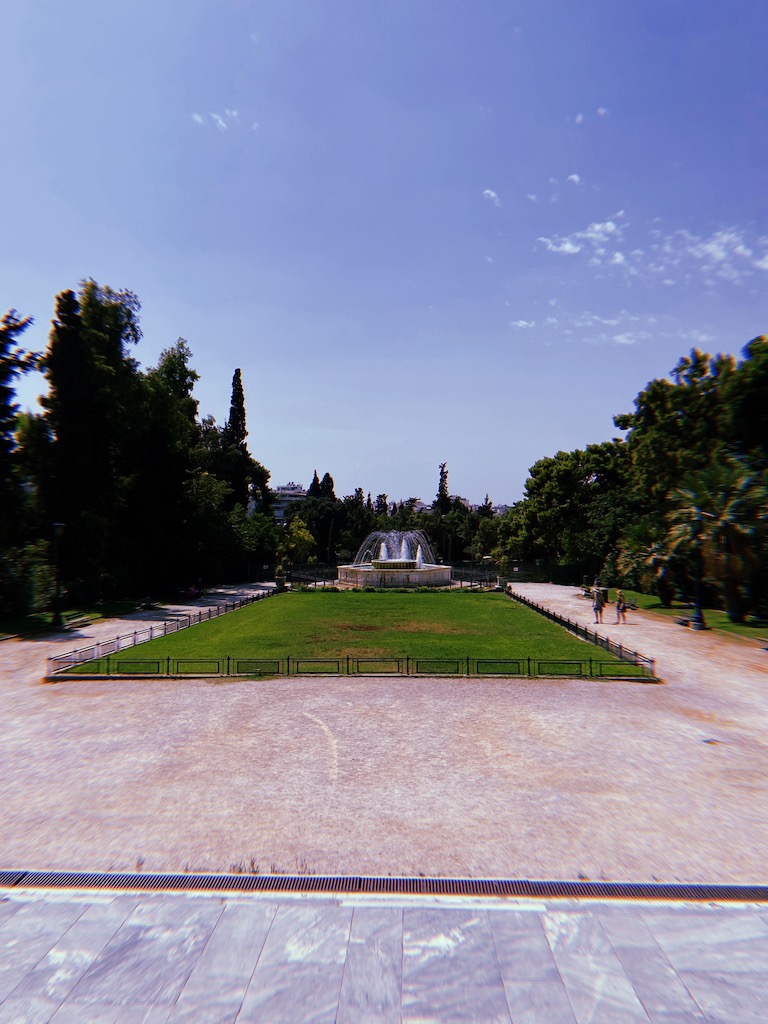
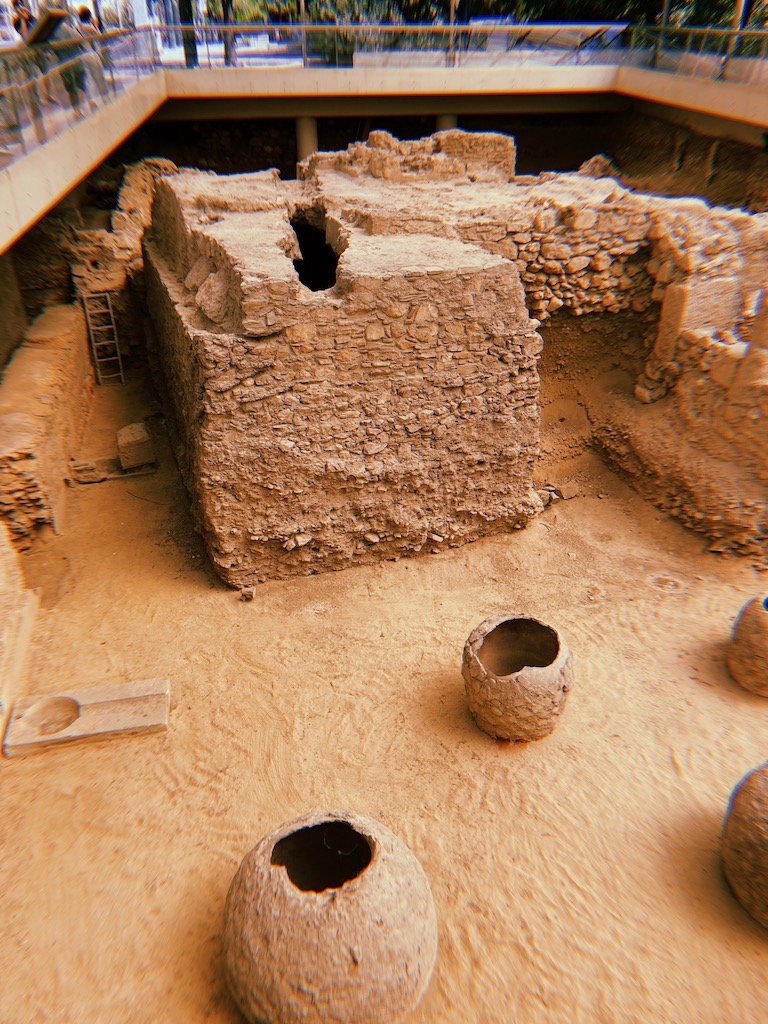
Nearby, the Zappeio Roman Baths are an archaeological site that provides a glimpse into ancient Athens. These well-preserved ruins date back to the Roman period and offer insights into the bathing and recreational practices of the time. Together, the Zappeion, Zappeion Garden, and Zappeio Roman Baths form a historical and cultural complex that adds depth and charm to Athens’ urban landscape, attracting both history enthusiasts and those seeking serene moments in the city.
The national garden (Εθνικός Κήπος)
The National Garden of Athens, often referred to as the “Ethnikos Kipos” in Greek, is a tranquil oasis nestled in the heart of the bustling Greek capital. Spanning approximately 38 acres, this lush green space offers respite from the city’s urban hustle and bustle.
Originally designed in the 19th century as the Royal Garden for Queen Amalia, it is a testament to Greek landscape architecture and features a rich variety of plants, trees, and wildlife. Strolling through its winding paths, visitors can admire neoclassical sculptures, charming lakes, and picturesque bridges. The garden also houses a small zoo and a playground, making it a family-friendly destination.
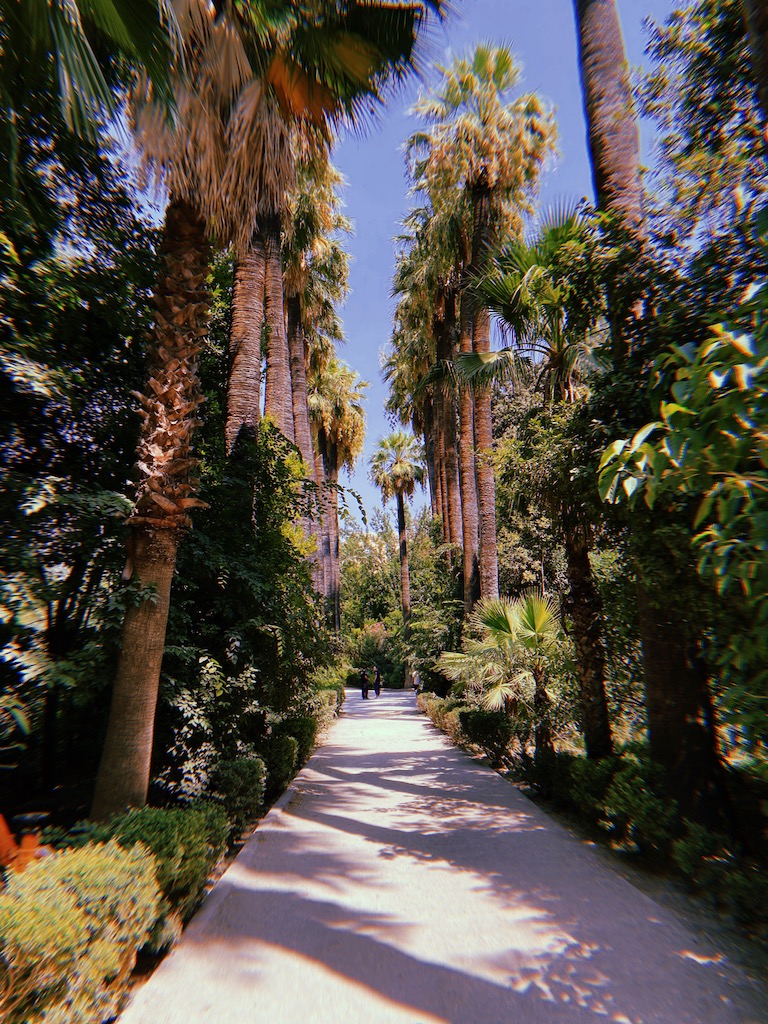
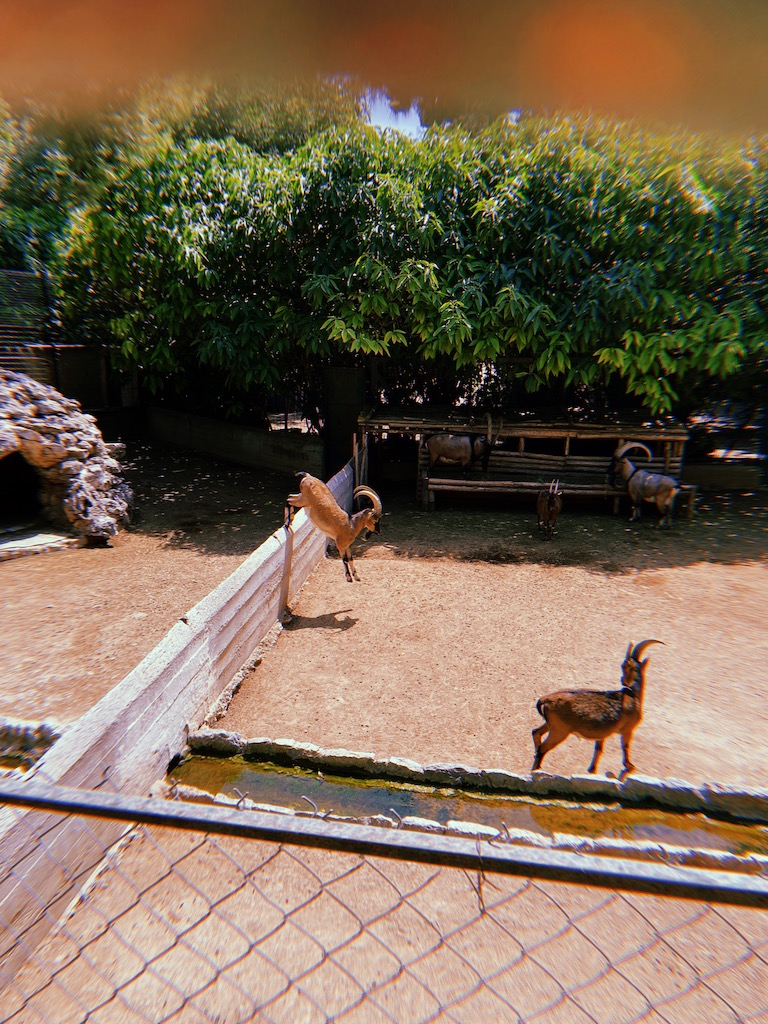
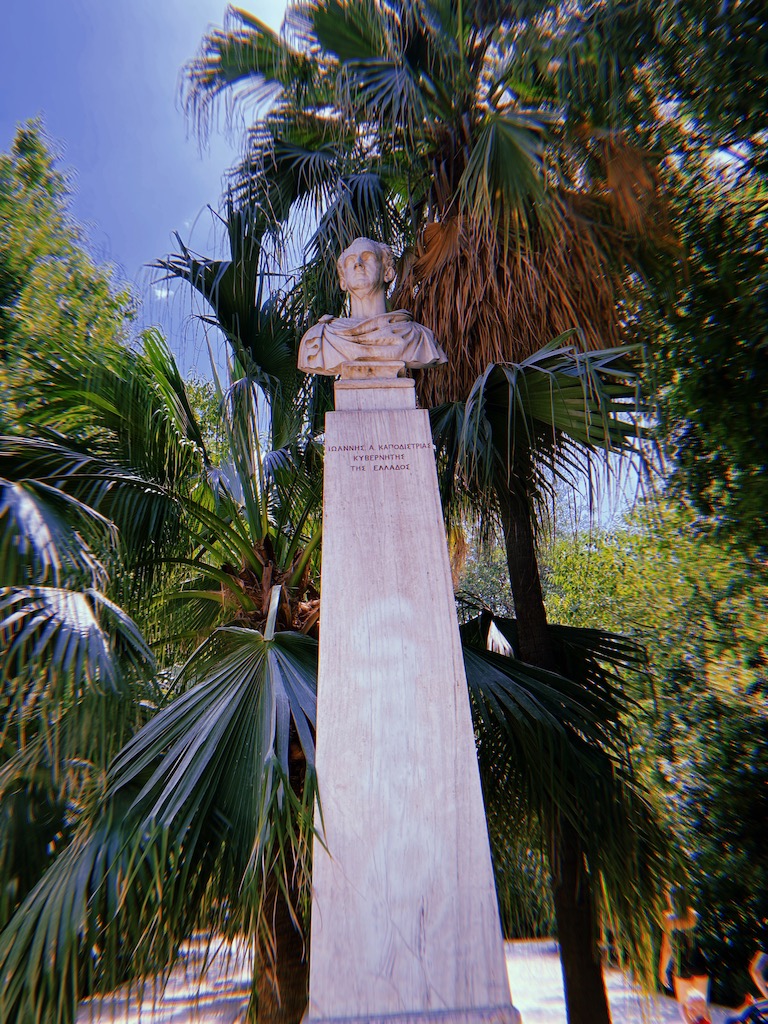
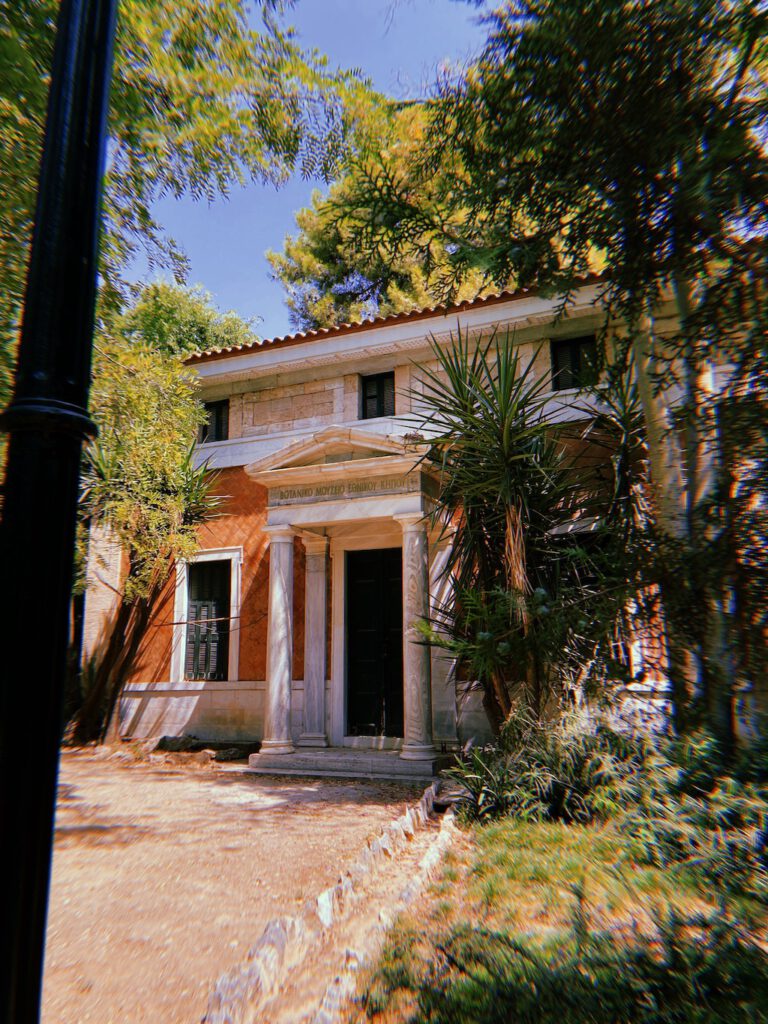
Greece Parliament (Βουλή των Ελλήνων) and Syntagma
The Greek Parliament, known as the “Hellenic Parliament” or “Vouli ton Ellinon” in Greek, is a significant political institution located in the heart of Athens. Housed in the impressive Old Royal Palace, which was originally built as a palace for the Greek monarchy in the 19th century, it serves as the legislative body of the Hellenic Republic.
The building itself is a striking example of neoclassical architecture, featuring a grand facade adorned with Corinthian columns and an iconic statue of Athena, the goddess of wisdom, above the entrance. Inside, the parliament chambers are where elected representatives gather to debate and pass laws that govern the nation.
Piraeus harbor (Πειραιάς)
The Piraeus Harbor, known as “Piraeus Port” in Greek, is one of the Mediterranean’s most important and bustling seaports. Located just southwest of Athens, Piraeus has a history dating back to ancient times, when it served as the primary port of Athens. Today, it remains a vital gateway for maritime trade, tourism, and ferry services connecting mainland Greece to the Greek islands.
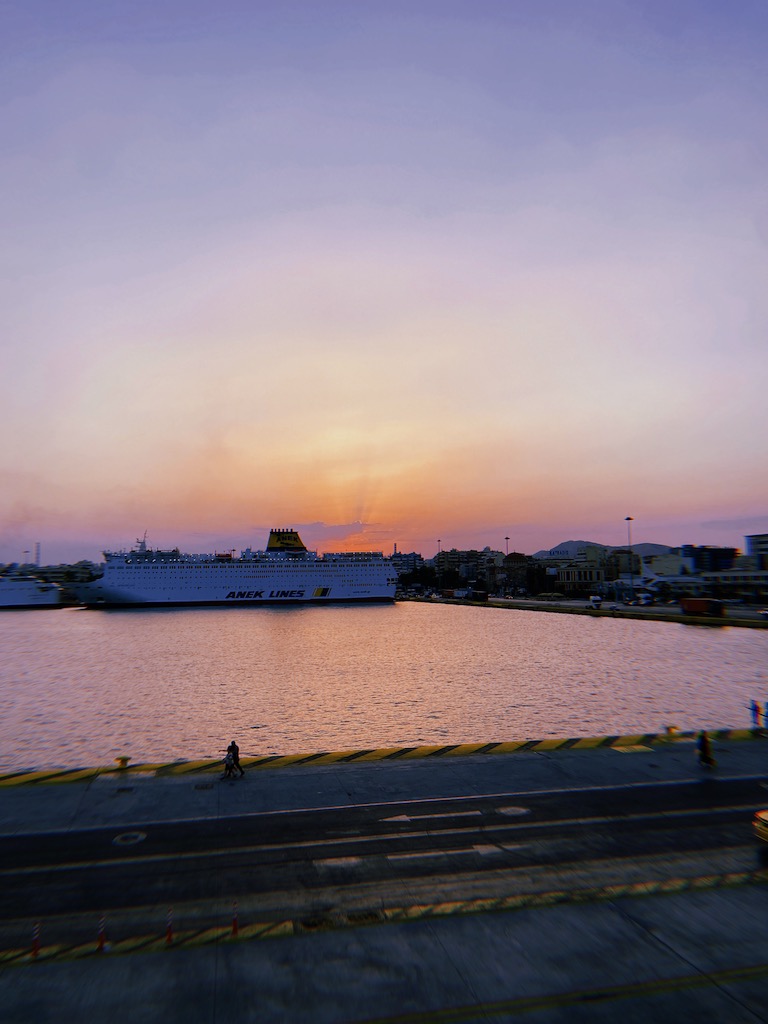
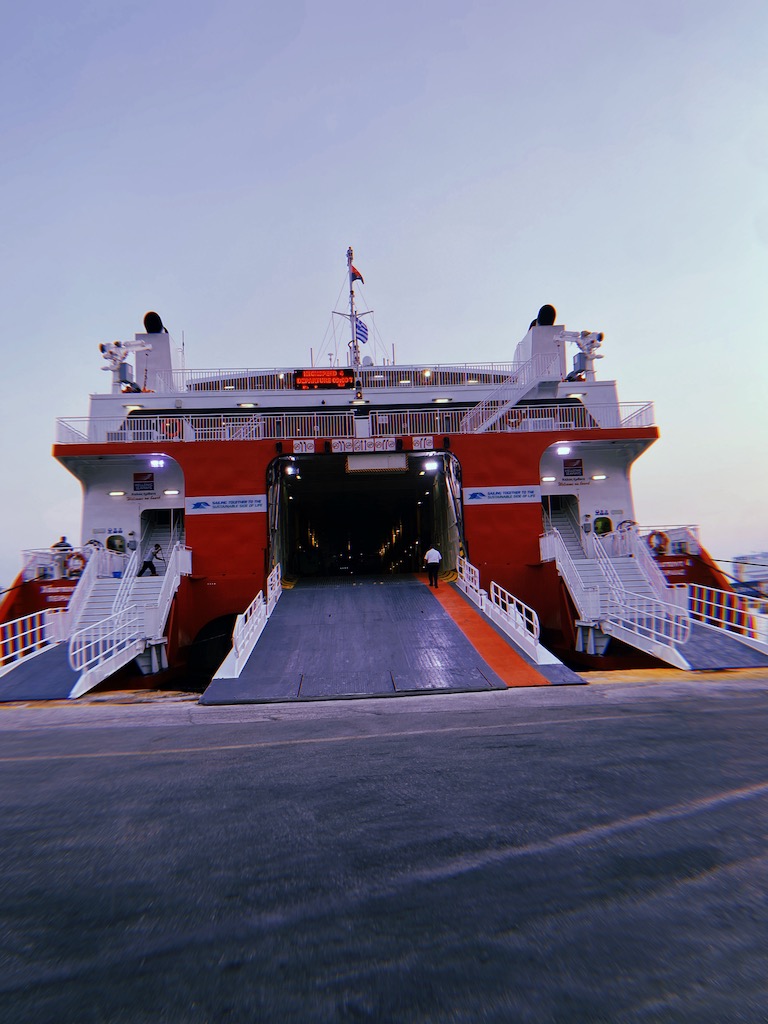
The port is a hive of activity, with various docks catering to different types of vessels, from commercial container ships to passenger ferries. Piraeus Harbor is not only a key driver of Greece’s economy but also a hub for cruise ships, making it a popular entry point for travelers exploring the Greek islands and Athens.
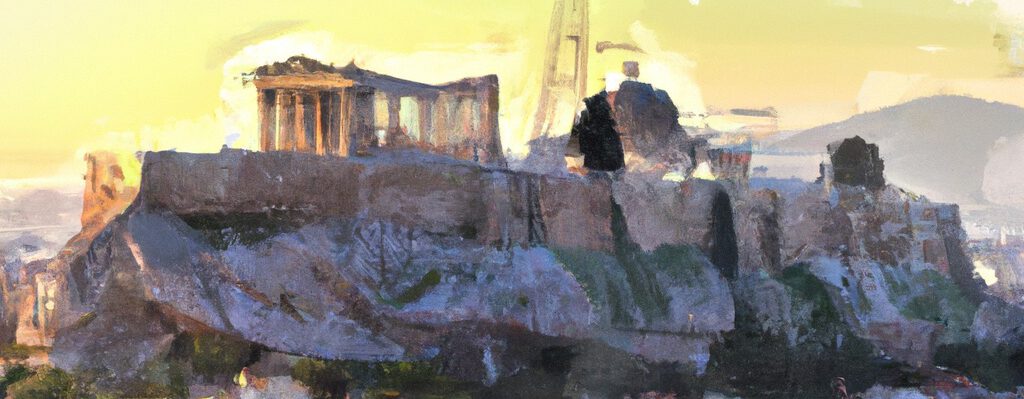
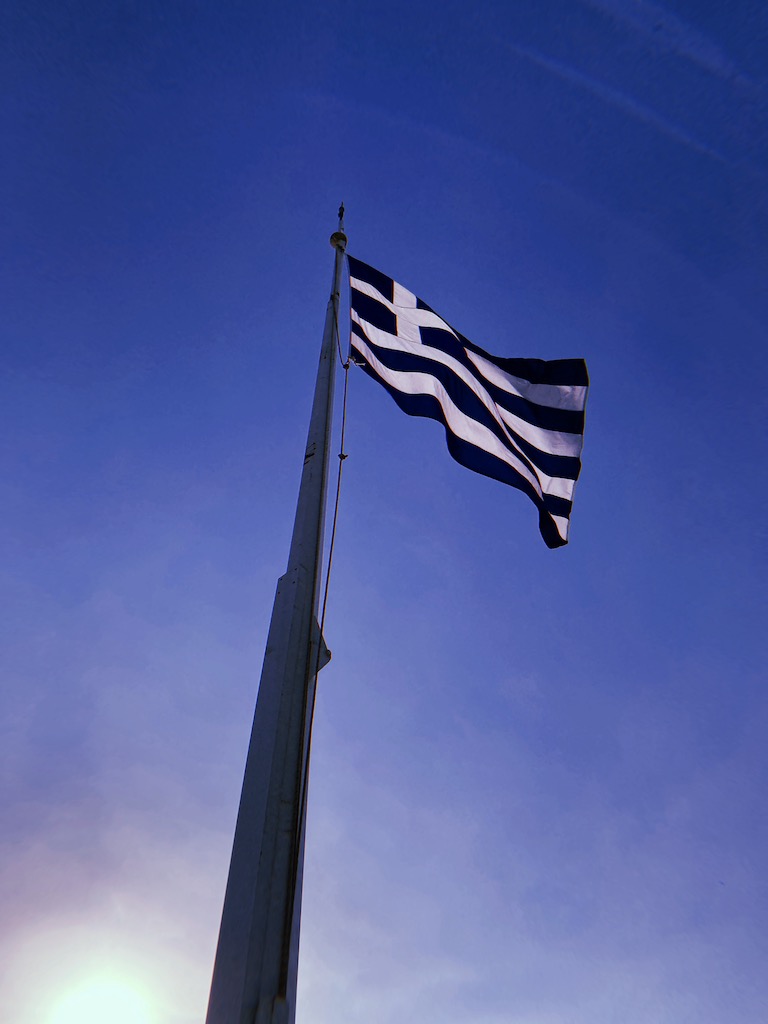
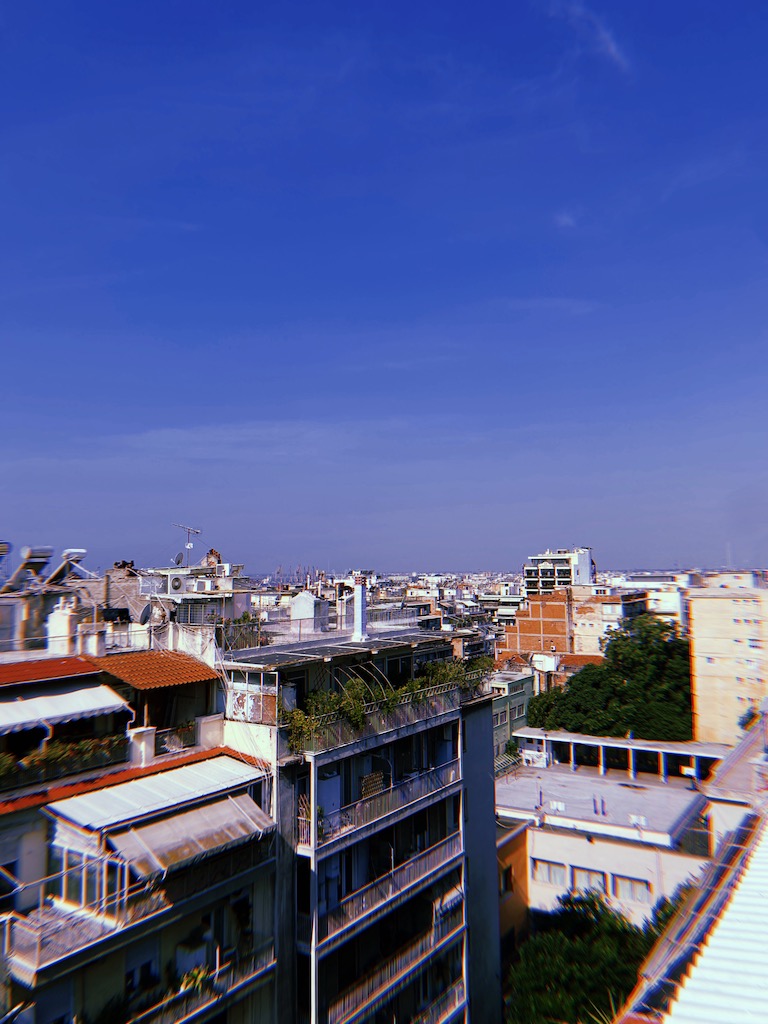

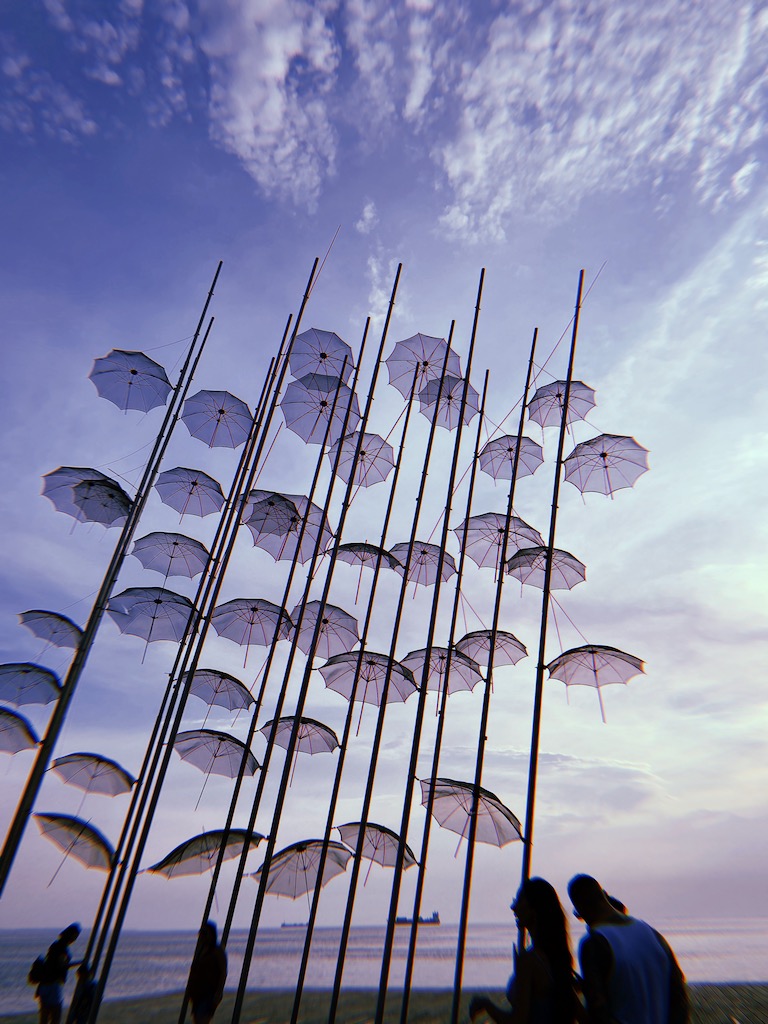
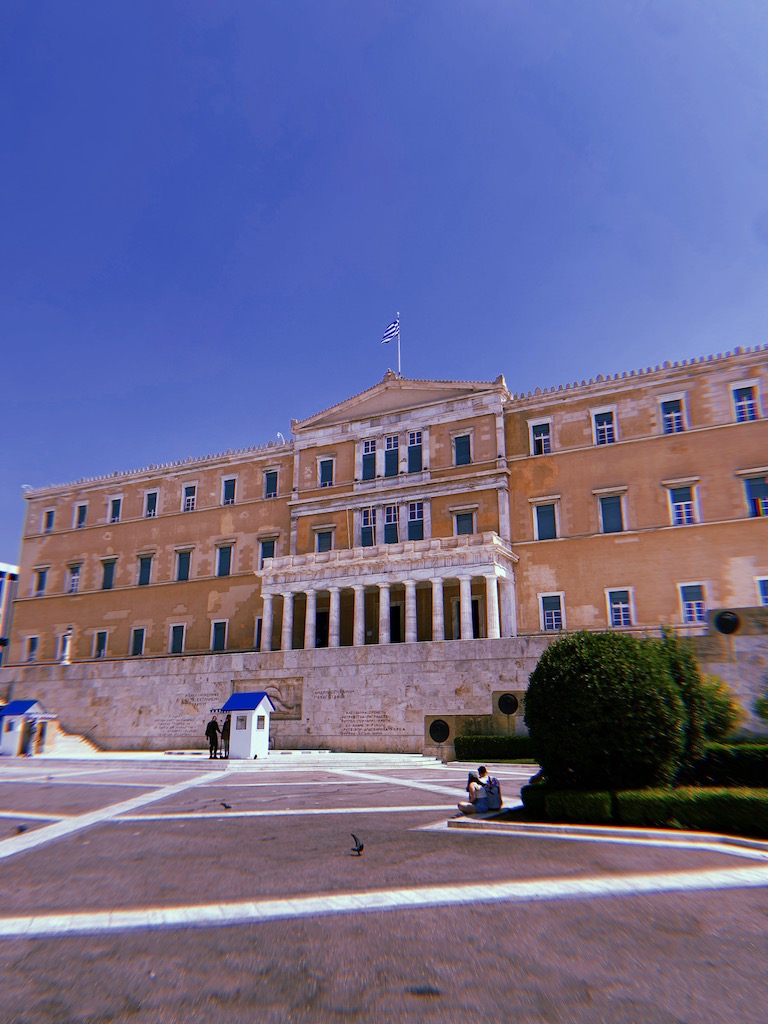
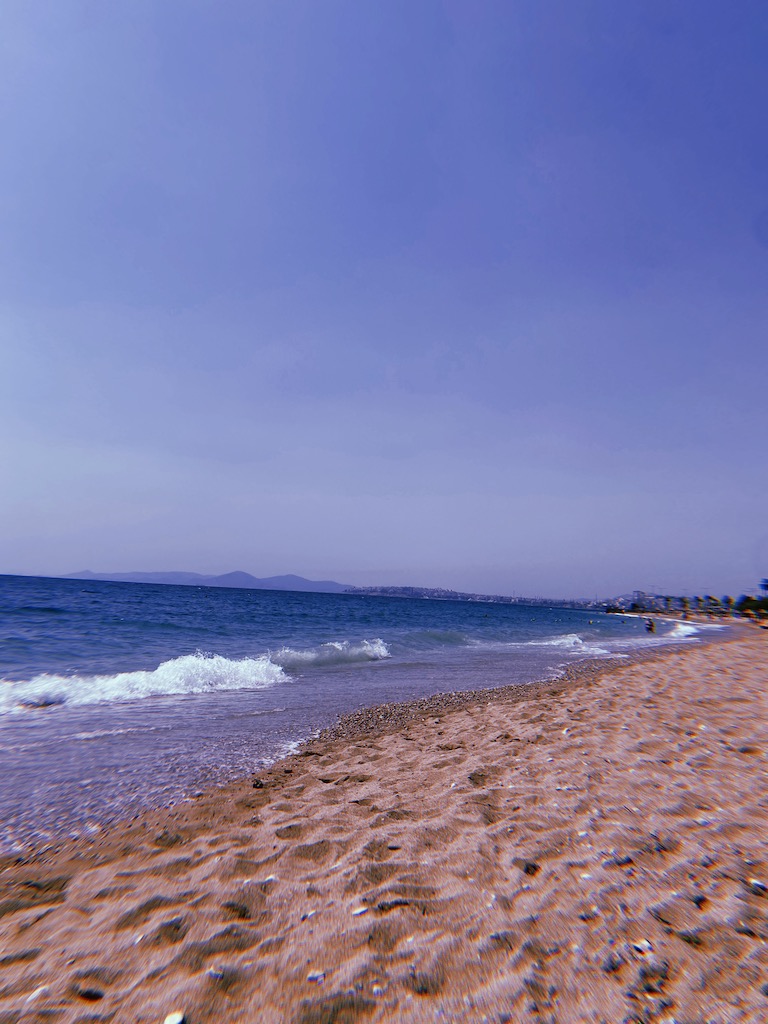
Leave a Reply